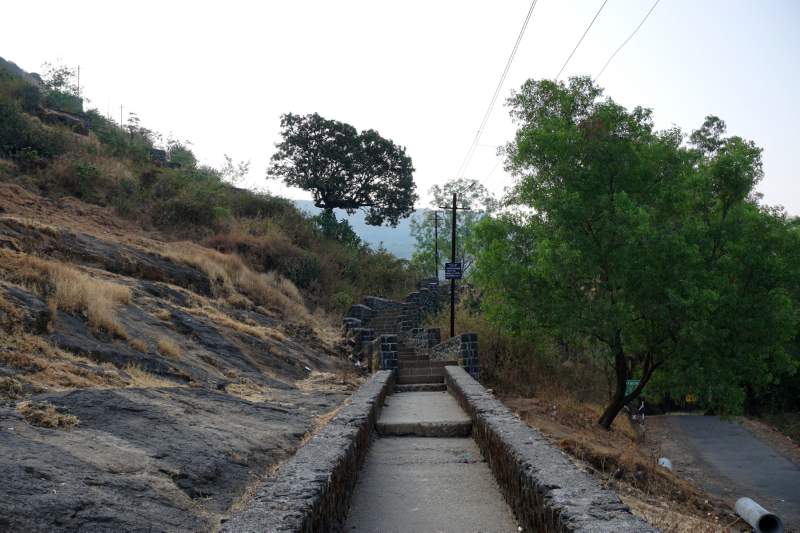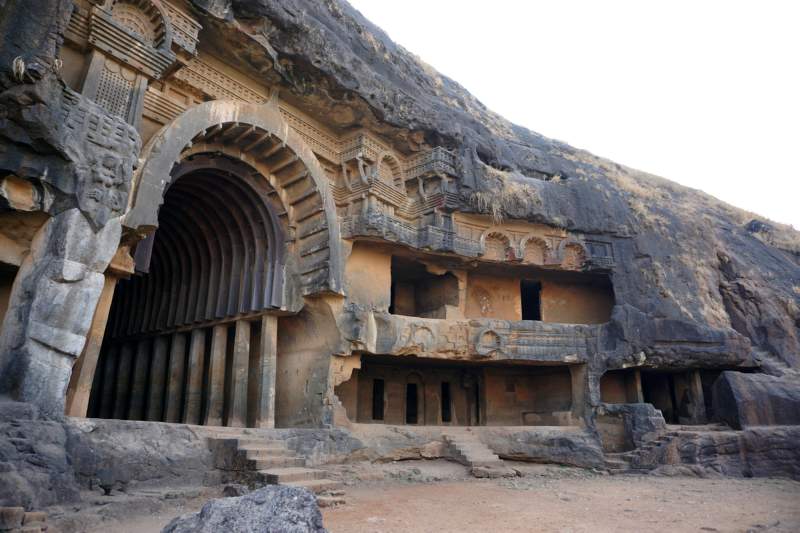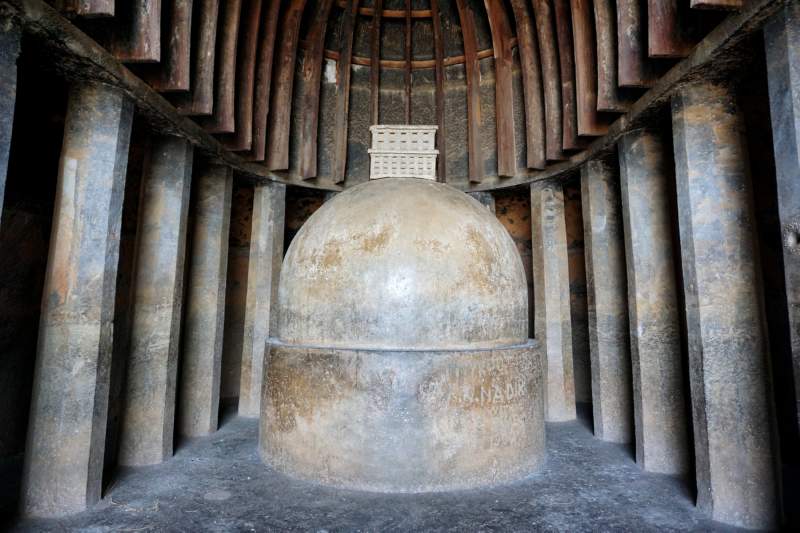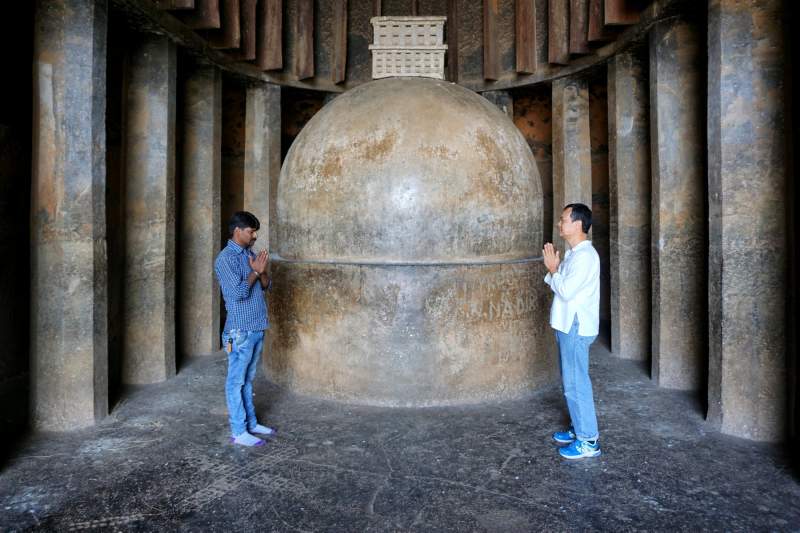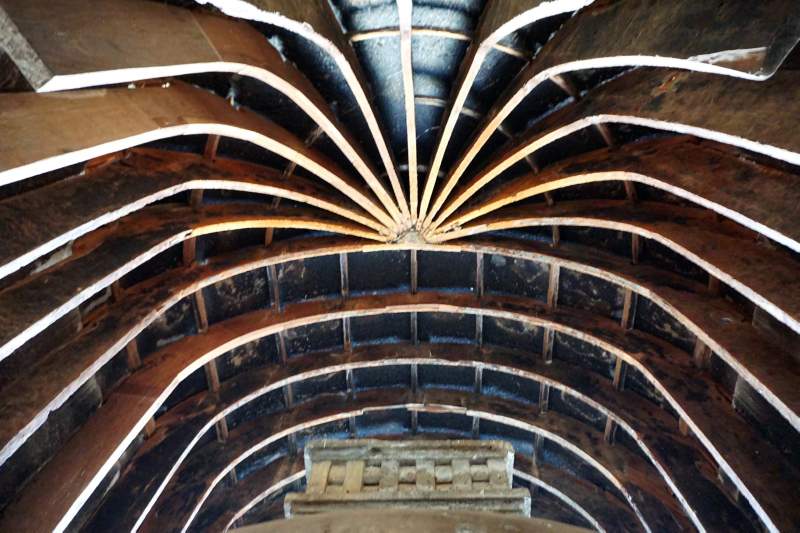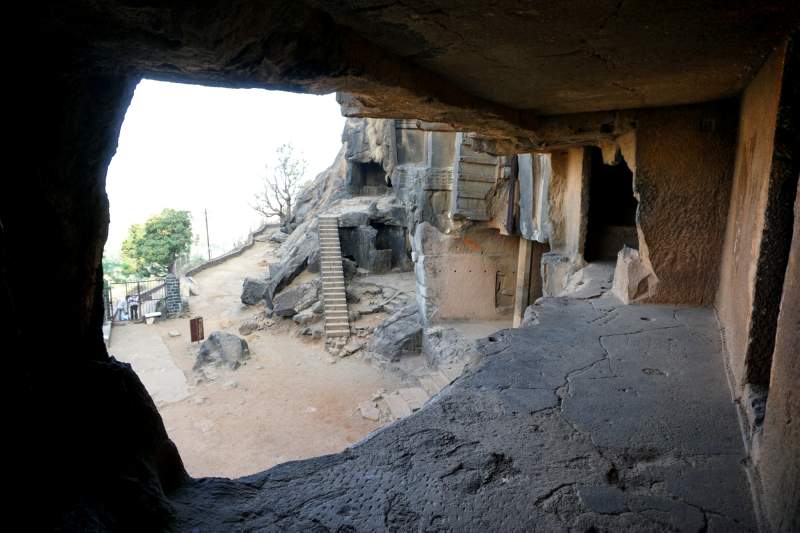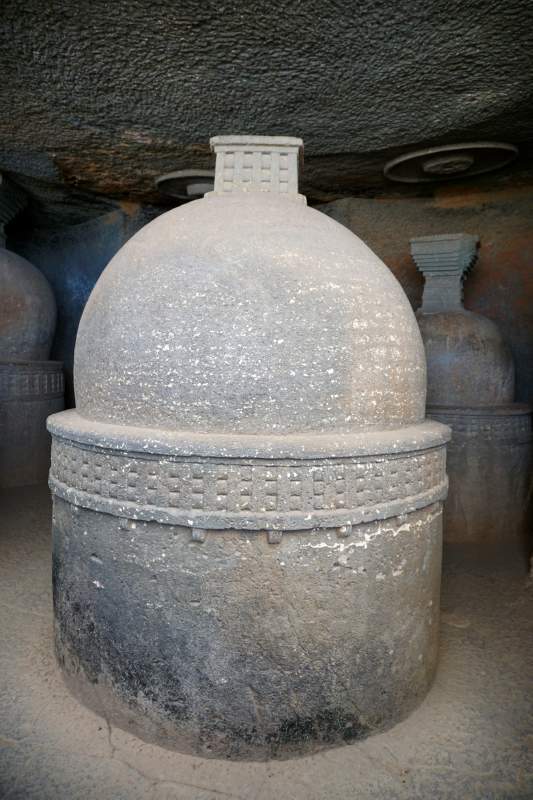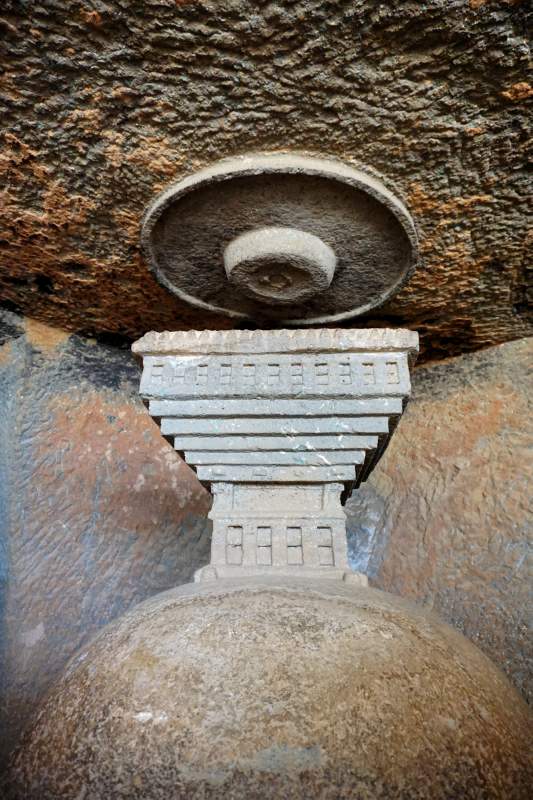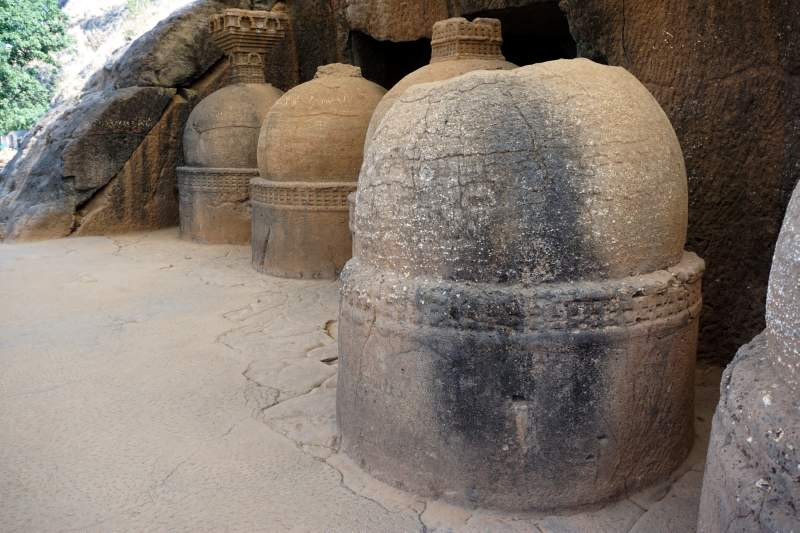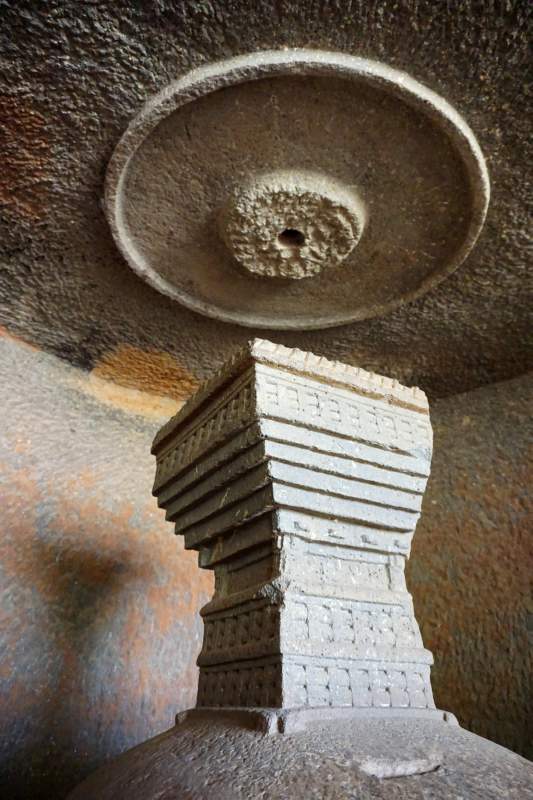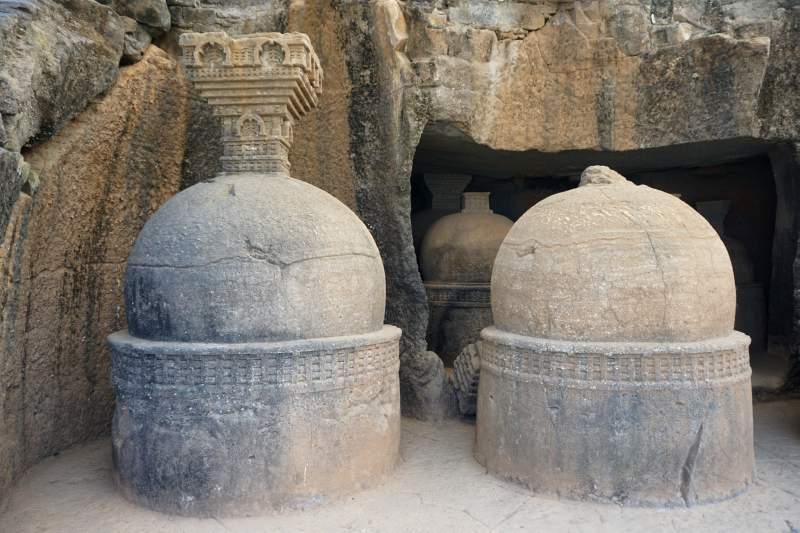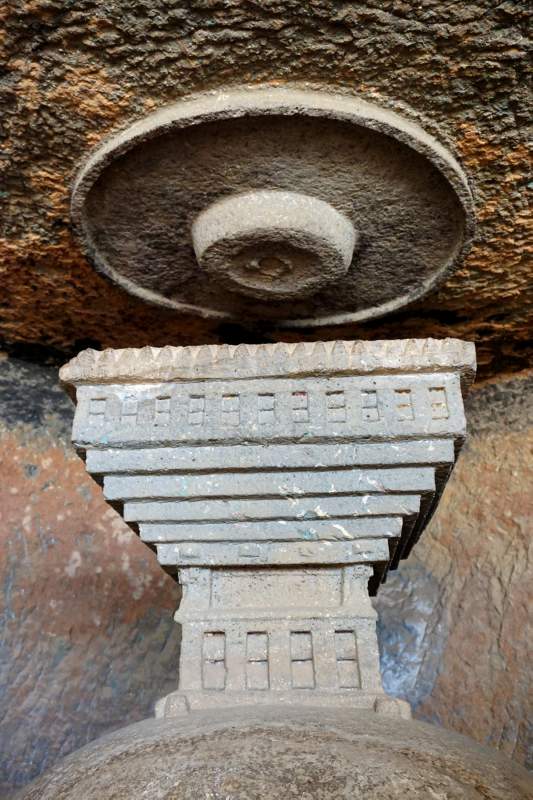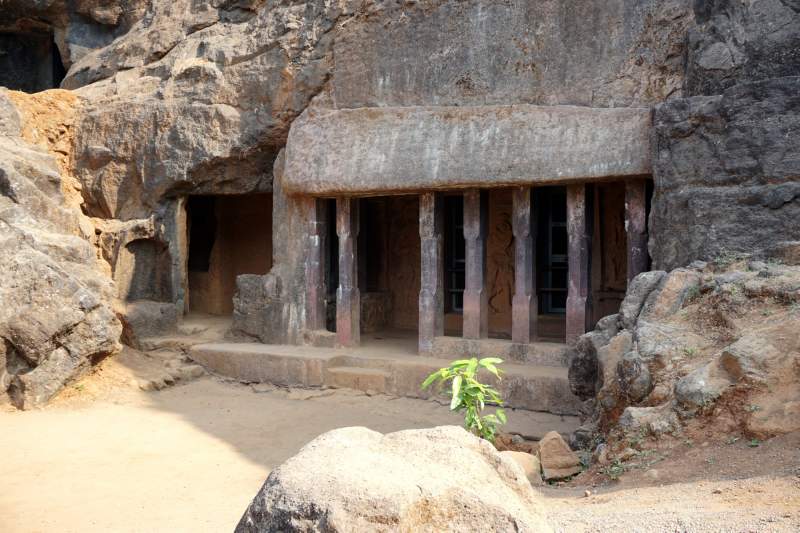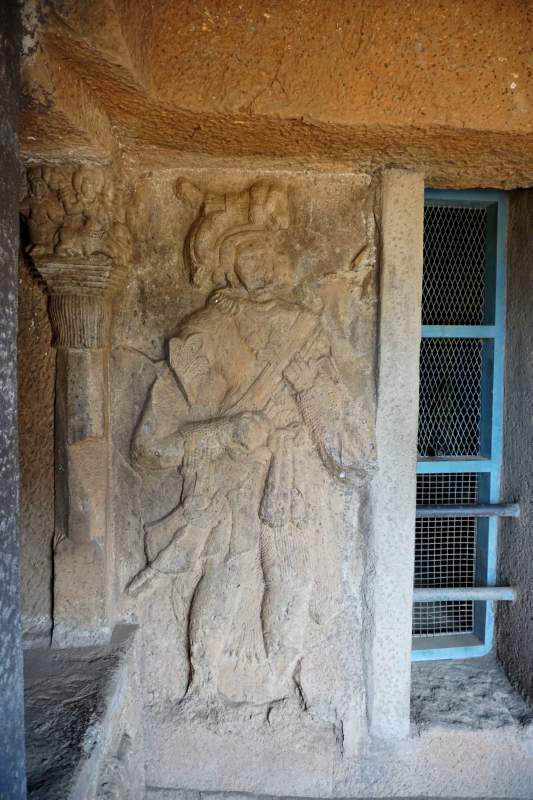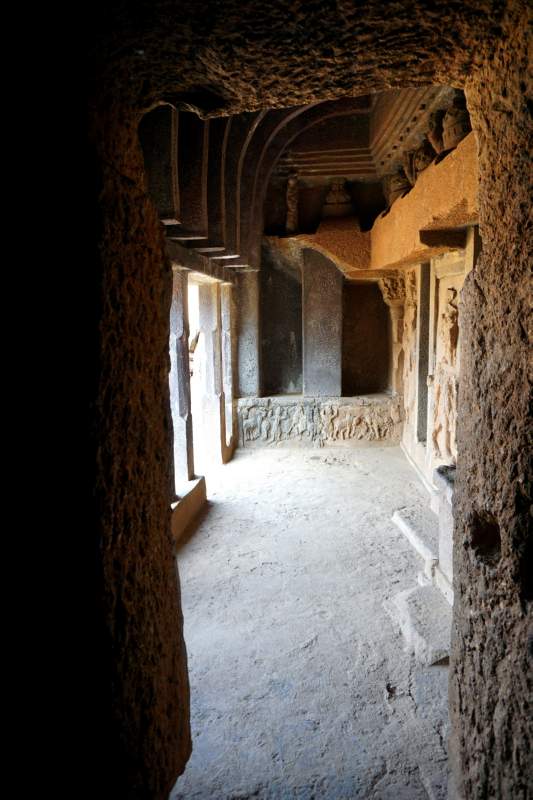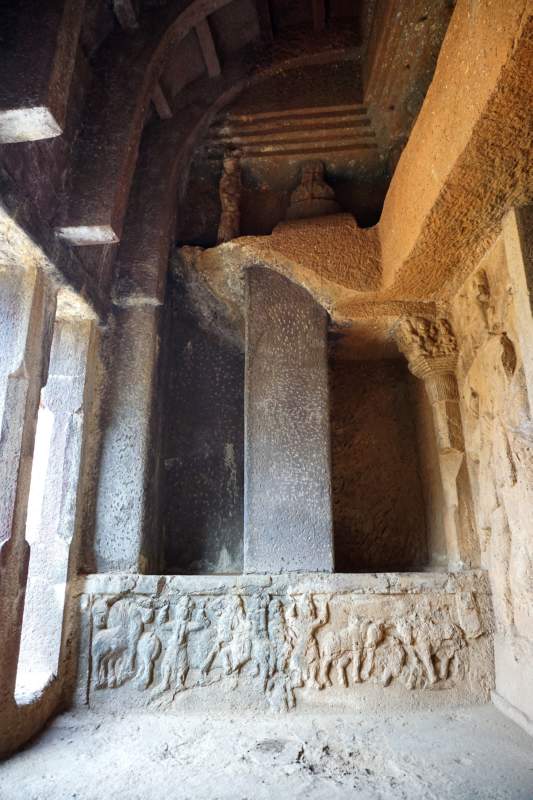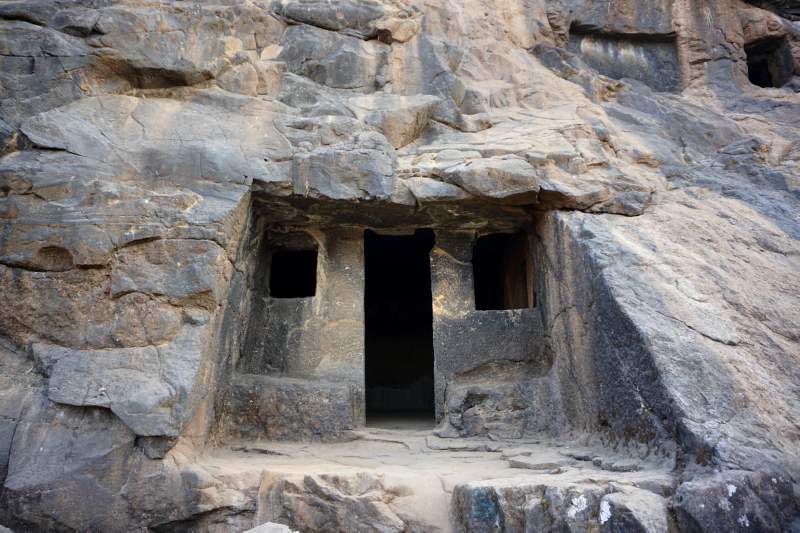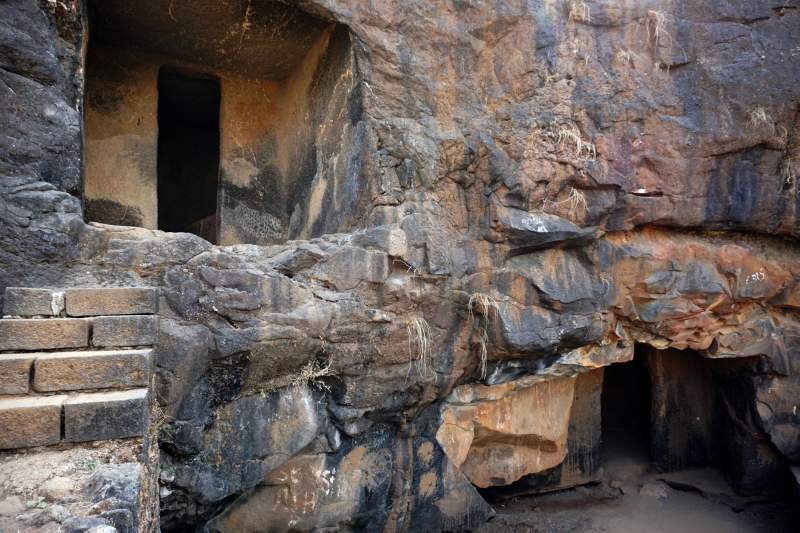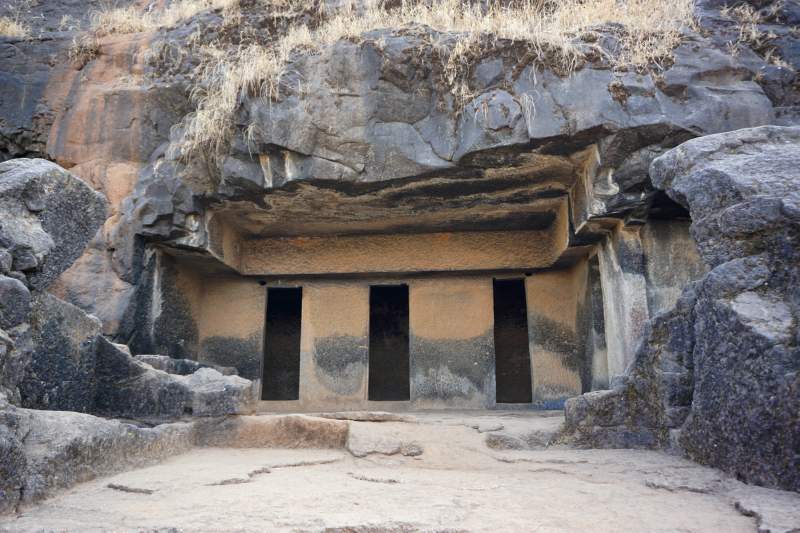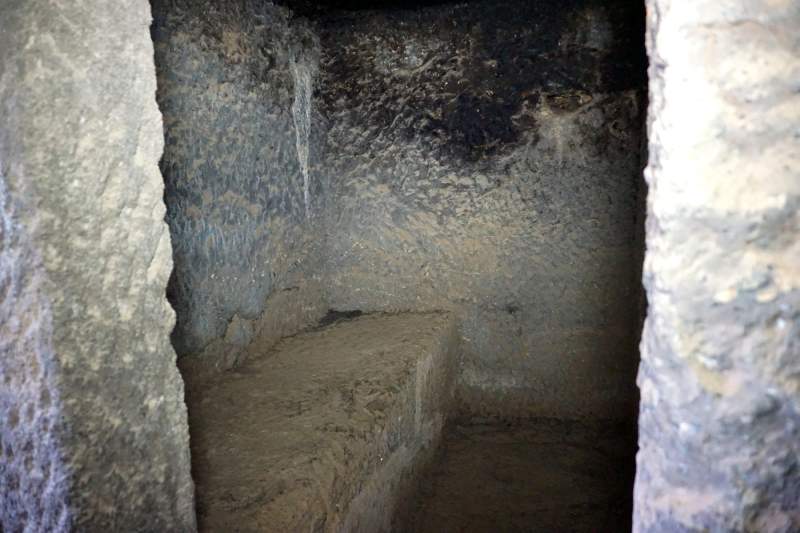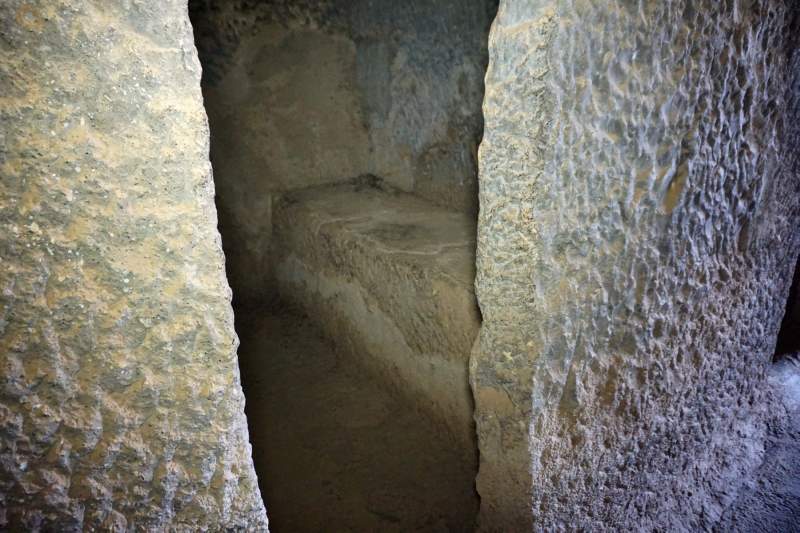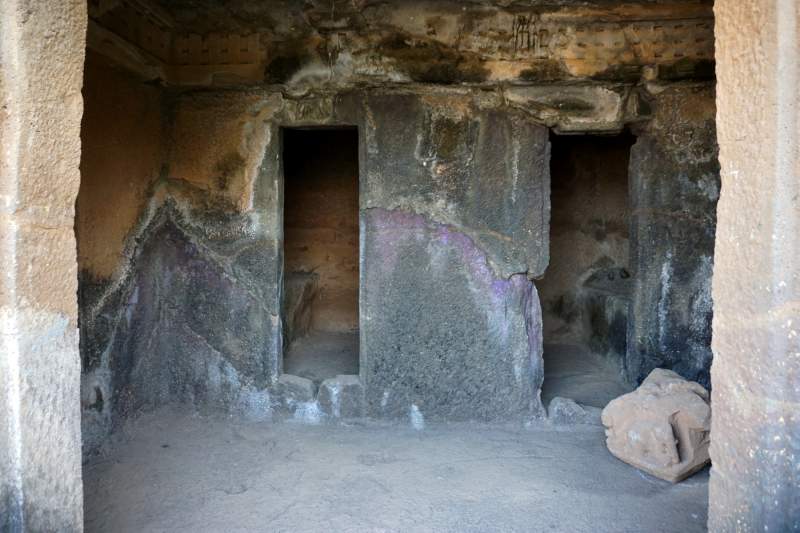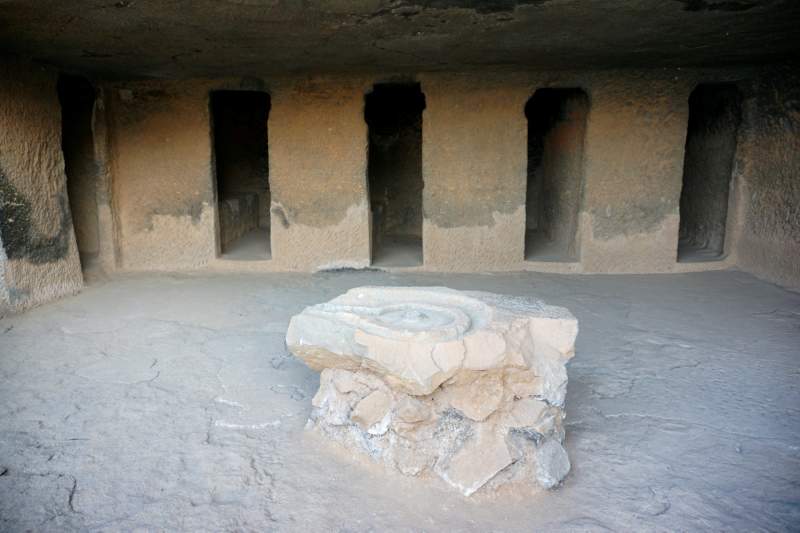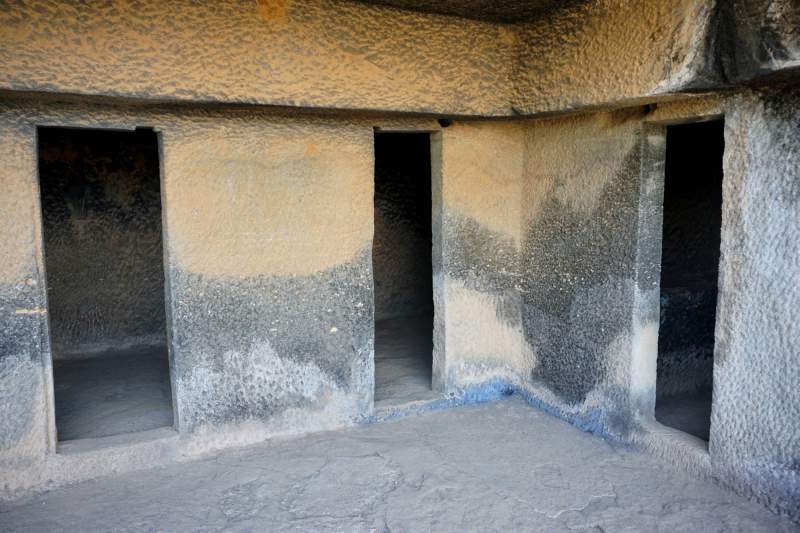Bhājā Caves, Lonavala, Maharasthra
high-definition creative commons photographs from the Bhājā caves near Lonavala, a group of some of the earliest rock-cut caves in western India, including a fine Chaitya Hall, together with some further information.
The Bhājā Caves
The first set of caves we visited in Maharasthra is the Bhājā caves, one of the earliest of the caves in western India, dating to not long after the time of King Asoka, around 2nd c. BCE.
There is a fairly steep climb up the hill to reach the site, which is fenced off. A few metres before the entrance is a ticket office, but it was not open when we arrived. After some time someone came with a key to let us in and took Rs. 200 for entrance fee.
The site itself can be divided into three sections. Upon entry the first section contains the Chaitya hall and fanning out around it vihāra rooms, where the monastics would have lived.
The Chaitya hall shows signs of being influenced by wooden architecture, both in its general design, and in its decorations. The entrance to the hall slopes inwards as though to distribute the weight, which would have been necessary if it was wooden, but with stone, of course, is not needed.
The Chaitya hall itself is fairly well-preserved, though there are signs of graffiti in places, including on the chaitya itself. It has ancient wooden rafters, perhaps made of teak, still in place, even after 2,200 years, and the decoration is simpler here than at later sites.
To left and right of the Chaitya hall there are vihāras, or monks' quarters, generally a small room with a stone bed or two, which would presumably have been covered straw, or something similar.
We did spend some time in meditation here, and as there were no other visitors, and until just before we left around noon the atmosphere was very quiet and peaceful.
The second section is a group of fourteen small Chaityas on the outside of the rock and inside a cave, which have been built for distinguished monks who presumably resided at the caves. To preserve them the authorities have seen fit to erect a very ugly plastic cover over them, which very much ruins the aesthetic.
Further on from this is another vihāra group, one of which is very special, having very fine carving on the outside of the rooms, depicting various scenes. The other vihāras are less elaborate, but interesting nevertheless.
Another notable feature is the cisterns, collecting water which has seeped through the rock, which would have provided natural mineral water. The site, when we were there, in February, was very dry and hot, but it is noticeably cooler inside the caves. The view from the caves over the surrounding countryside was good and clear.
In retrospect the Bhaja caves seem to have been some of the best preserved of the caves we visited, not suffering too much damage on the one hand, and as far as I could see, no encroachment from Hindu worshippers on the other.
use j/k or left/right arrow
to navigate through the photos below
Approach and Surrounding Countryside
Panoramas
you can control the movement through the panorama with your mouse
The Chaitya Hall
The Chaitya Group
The New Cave and Verandah
Other Caves

Description from the Poona Gazetteer of 1885 [1]
(slightly re-edited, with additions from various sources)
Bhāja, a small village .. in Maval about seven miles south-west of Khadkala and about two miles south of Karle railway station, has a group of about eighteen early Buddhist caves of about the second and first century B.C. ... The caves are about 400 feet above the village in the west face of a steep hill. Beginning from the north the first is apparently a natural cavern thirty feet long and slightly enlarged. The next ten are plain cells. Cave VI. is an irregular cell much ruined... The hall is irregular about fourteen feet square with two cells on each side and three in the back wall with chaitya window ornaments over all the cell doors. Over the right side cell door in the back wall is and inscription recording
Inscription 1
'The gift of Bādhā (Bodhi) a ploughman's wife.'
On the back wall of cave IX is a frieze projecting 2' 2" with, four chaitya arches joined by the rail pattern. In front of the cave was a Verandah which seems to have had pillars with animal capitals. A fragment of the base of a pillar is left as also a broken capital with animal figures upon it.
Cave XII
The chaitya or chapel is the best in the group, one of the most interesting in India, and, according to Dr. Burgess, one of the most important to be found anywhere for the history of cave architecture. The cave is fifty-nine feet long by about twenty-nine feet wide with a semicircular apse at the back and having an aisle 3' 5" wide separated from the nave by twenty-seven plain octagonal shafts 11' 4" high. The pillars rake inwards about 5" on each side, so that the nave is 15' 6" wide at the tops of the pillars and 16' 4" at their bases. The dagoba or relic shrine is eleven feet in diameter at the floor and the cylinder or drum is four feet high. The dome is six feet high and the box upon it is two storeyed, the upper box being hewn out 1' 7" square inside with a hole in the bottom 1' 8" deep and 7" in diameter. The upper part of the box or capital is of a separate stone and hewn out, showing clearly that it held some relic. On four of the pillars are carved in low relief seven ornaments or Buddhist symbols. On the left of the seventh pillar is a symbol formed of four tridents round a centre which perhaps contained a fan with buds and leaves at the corners. On the eighth pillar, on the right side are two flowers and what looks like a fan and on the left side a posy of holy flowers.
The roof is arched, the arch rising from a narrow ledge over the triforium 7' 5" above the tops of the pillars and 26' 5" high from the floor. The roof is ribbed inside with teak girders the first four of which, and parts of some of the others, have given way or been pulled down. The front must have been entirely of wood and four holes are made in the floor showing the position of the chief uprights. There are also mortices cut in the rock showing where one of the chief cross beams must have been placed, probably to secure the lattice work in the upper part of the window. The front of the great arch is full of pin holes in three rows, about 170 in all, showing beyond doubt that some wooden, probably ornamental, facing covered the whole of the front.
The figures on the front are a female figure high up on the left much weatherworn but with a beaded belt about the lions; two half figures looking out at a window in the projecting side to the right of the great arch and on the same side the heads of two others in two small compartments and on a level with the top of the arch.
By the side of Cave XII, but with the line of its front coming out to the south at a small angle, is Cave XIII the front quite gone and probably of wood. The cave (30' X 14' 6") has a cell in each of the back corners and three in the back wall. Each cell has a latticed window. The left cell has a fastening on the door as if for a lock or bolt. The right cell has an arched door and a stone bench. Of the back wall cells two on the sides have a single bench, and the middle cell has two with a small recess under each. Over the doors of all the cells is the chaitya arch joined by a frieze of rail pattern.
Over the front of the cave are ornamental arches and a double course of rail pattern. Close to Cave XIII, and facing a little more to the north, is cave XIV (6' 8" x 25' 6") with one cell at the back and three on each side. The front cells have double beds with a recess under each; the second on the left has no bed but a square window and the third on the right has no bed but leads into an inner cell with a stone bench. Cave XV is above Cave XIII and with Cave XVI is reached by a stair to the south of Cave XIV. It is a small dwelling cave (12' 6" x 10') with a bench on the right and two semicircular niches 2' 8" wide with arched tops surmounted by the chaitya arch.
At the back are two benched cells. The front wall is gone; the terrace in front was about five feet wide and probably, as shown by holes in the roof, framed in wood work and projecting forwards. The front above this cave and cave XVI is carved with thin chaitya arches and the rail pattern.
Cave XVII reached by a descent from caves XV and XVI is a small dwelling cave (18' 6" x 12' 6") with three cells at the back and two at the right, one of them with a bench. There is also a bench in the left end of the hall and an irregular recess or cell. On the right, near the door of the second cell, is inscription two in two lines which records:
Inscription 2
'The gift of a cell from Nādasava, a Nāya of Bhogavati.'
Inscription 3
Near the cave are two wells in a recess and over them is inscription three in two lines which records:
'The religious gift of a cistern by Vinhudata, son of Kosiki a great warrior.'
At some distance along the scarp is a large excavation containing a group of fourteen relic shrines or dagobas of various sizes cut in the rock. As their inscriptions show, they are the tombs or stupas of monks. All have the Buddhist rail pattern round the upper part of the drum. Five of them are under the rock and vary in diameter from 6' 3" to 4' 8" and of these two in front have the relic box only on the dome while the three behind them have also heavy capitals, the largest on the left joined to the roof by the stone shaft of the umbrella, while, over the other two, the circle of the umbrella is carved on the roof with a hole in the centre over a corresponding hole in the capital, evidently to insert a wooden rod.
Of the nine dagobas outside the rock roof, the first to the north has a handsome capital 3' 8" high and is very elaborately carved. As most of the other dagobas are broken, it cannot be said how they were finished except that the eighth and possibly others were of the plain box form without any cornice. In four of the capitals under the roof are holes on the upper surface as if for placing relics and two have a depression round the edge of the hole as if for a closely fitting cover.
Inscriptions 4-8
On the second dagoba, going from north-east to south-west, in the front row is a weather-worn inscription in one line recording:
'The stūpa of the venerable reverend Dhamagiri.'
On the base of the third dagoba is inscription five in one line recording.
'The stūpa of the venerable reverend Ainpikinaka.'
On the base of the fourth dagoba is inscription six in one very indistinct line recording:
'The stūpa of the venerable reverend Sanghadina.'
On the capital of one of the dagobas under the rock is inscription seven in one line recording:
'The venerable reverend.'
There is an eighth inscription much weather-worn and difficult to read on the dome of the large relic shrine which stands first in the front row.
Farther along the hill scarp is a small chamber, with a cell at the right end, much filled up, but with a frieze, ornamented by female figures and relic shrines in high relief, supporting a moulding with relic shrines in half relief and with an arched roof only half of which remains. On the wall are some curious sculptures. Farther along the hill scarp, under the first waterfall, is a small empty round cell; under the second is a large square room with three cells at each side, partly filled and much ruined; under the third waterfall is a small round cell with a relic shrine.
New Cave and Verandah Sculptures
In 1879 a very old and most interesting cave was discovered in the Bhaja scarp further to the east. When first found, the cave was filled nearly to the roof of the Verandah with mud and earth. The Verandah pillars and the sides of the entrance doors are broken away. The cave faces north and is a small dwelling cave with a somewhat irregular hall (16' 6" X 17' 6"). There are two cells in the inner wall one of them with a stone bed and two in the east wall. The cave has three other cells, a large cell with a stone bed at one end of the Verandah and two smaller with benches at the other end. At one end is a pillar and pilaster with bell and pot-shaped capitals. The pillar and pilaster are surmounted by fabulous animals, human female busts with the bodies of cows. The cave has some remarkable sculptures in the hall and verandah.
On the left wall of the cave is a standing male figure (5' 9" x 2' 8") with lips compressed, no facial hair, and feet carved as if walking towards the right. The legs are crossed, the right leg brought behind the left leg. The left hand holds the hilt of a heavy thick dagger that is tied on the left hip. The right hand grasps a spear. The headdress is curious and heavy. The hair is rolled into a big dome. There are heavy earrings with five rings and a heavy double necklace. On the upper arms is a broad belt with pointed side plaits. On the lower arm are five bracelets. The figure wears a waistcloth. Over the right shoulder is the sacred thread. The feet are bare. The dagger on the left hip is heavy and broad-bladed; the spear has a head like a modern spear, and a knobbed head on the ground like a mace. The other figure (3' 7" x 1' 6") on the left wall is also standing. It holds a spear in the right hand and the left hand rests on the waistband. A shoulder cloth is thrown over the left shoulder. The hair is tied in a dome which is not properly finished. In the back wall of the cave below is a small figure holding up the seat and on the right side is another small figure.
In the left end of the verandah the small central pillar has a capital carved into figures, a horse below and a woman from the waist up. The right hand holds up the roof. The figure has a curious head dress as if the hair was done up with wreaths of pearl, and big earrings, double necklace, and hanging stomacher. The right corner of the capital is another female centaur with triple and fivefold bracelets. Between the earrings is a female head. The figures at the side of the capitals are like the sphinx in the Karle chapel cave. In the corner are more centaurs male and female with different head-dresses and not holding up the roof.
In the front wall on the left is a standing male figure with the hair tied into a great domed headdress. He holds a double spear in his left hand which is held to his breast and his right hand rests on the handle of a broadbladed kukari like dagger. Below the sheath of the dagger show the ends of the double spear. The case of the dagger is tied on with a cloth. On his upper arms great ornaments stretch from near the elbow to the shoulder. In the ears are huge earrings and round the neck is an elaborately carved necklace. Many threads are gathered together with a plate or madalia. Above is a double necklace, one of them with plates, the upper with beads like an amulet. The earrings are very heavy like a snake with seven coils. The face is broken. The figure wears elaborate bracelets in four sets of four rows each fastened into plates. A shoulder cloth is drawn over the left shoulder and round the waist is a thick waistcloth with many folds. There seem to be other skirts like a kilt.
The middle figure is a man with much bushy headdress, different from the last. He wears a necklace of big beads and below at the breast a double necklace. He wears a shoulder cloth or perhaps a sacred thread. His right hand held a dagger of which the case remains. Below a waistcloth falls nearly to the right ankle and to the left knee. His left hand held two spears of which the lower ends remain.
On the right are three figures; a standing male with a headdress like the first figure, the hair seeming to fall down the right shoulder. The figure wears a big hanging necklace; the earrings are different from the first figure but broken. There is a third necklace like a rich band, one side shown on the right chest and the other aide showing on the left. Behind the back is a quiver stocked with arrows. In his right hand is a bow and his left hand is on a dagger tied to his left hip. His feet are bare. His waistcloth hangs in heavy full folds.
To the right of this figure is a window of stone lattice work and below the window to the right are a male (1' 7" x 1' 2") and a female demon (2' 2" x 1 2"). The female demon is big and fat with staring eyes and a tremendous mouthful of teeth; in her raised right hand is a hammer. The male demon to the right is smaller and in trouble, his right hand being eaten by some large animal with crocodile-like jaws. Above the male demon is a man Indra on an Elephant, his feet in stirrups. He wears a necklace of great rows of beads. The horse has a jaunty or chhoga headdress. The rider holds the reins in his right hand and a spear in the left. His right foot is in a stirrup. A demon holds up the left hind and front feet of the horse. Below the horse's belly is a man like a king.
The group seems to represent a demon carrying off a king. On the right a king stands in a chariot like a Greek car drawn by four horses. He wears a double necklace like flowers, and a handsome headdress. With him in the chariot are two women, one behind him holds an umbrella the other in front has a flywhisk. They have rich ornaments and waistbands. The horses are treading the female demon who lies facedown. In the back ground is a chief. To the right is another curious group.
Below, near the lower left corner, is a chief seated one leg on the seat, the other hanging down, and close by on the very left is a sacred tree hung with garlands and rail at the foot. Close to the king's left a woman brings a spittoon and a water-pot; behind is a woman with a flywhisk and a man. Below is a group, a man playing a stringed instrument and a woman dancing. To the right of the tree is some wild animal perhaps a hippopotamus and below is a fallen bullock and further to the right a great crocodile's head. Above a woman with a horse's head clutches the shoulder cloth of a man on the left and is carrying him off.
A little above are two small elephant-like heads, a tiger eating a deer or a cow, and a small elephant gnawing at the foot of a big elephant, the central figure in the group. Above a small elephant kills a tiger and over it is a tree perhaps the Acacia cirisa. Higher to the left, above the seated king, is a sacred tree with many male and female figures on it, the men with headdresses like peaked nightcaps. Above, on the left, a male figure floats down, and from the right comes up a man with a dagger in his right hand.
On the large elephant which forms the central figure in the group rides a great king. Round his neck great garlands have been hung, which fall to his feet, and his arms, nearly up to the elbow, are encircled with bracelets of flowers. His right hand holds the elephant goad and his left hand is raised to his chest and grasps the flower garland. Behind him sits a small male figure with a coat and a striped waistcloth and a cloth wound round his face under the chin. In his hands he holds a double stick and a flag with a Buddhist trident above it. There is a man behind the elephant and something else like a tree. The elephant moves along carrying in his trunk an acacia tree torn up by the root...
On the inner wall above the door is a frieze of alternate stupas and figures holding up the roof. The stupas are somewhat like the Amaravati stupa. On the left side walls under the centaurs is a frieze close to the ground. In the left corner is a bullock, then a winged horse or bullock, next a standing man with his hands raised above his head. Then comes a chief-like or important personage well dressed on a horse his bare feet in stirrups. Then follow three men one above the other, then a man with both his hands raised over his head. Then two bulls goring a fallen male figure. The headdresses in the cave are like those in the Bharhut Stupa in the Central Provinces about a hundred miles north-east of Jabalpur, though the ornaments of the stupa are not so old.
From the position of the cave in a place not nearly so well suited for a cave as the big one (XII) it looks as if Cave XII was first made.
Photographs by Anandajoti Bhikkhu
About this Website

Creative Commons Attribution-ShareAlike 3.0 Unported License

